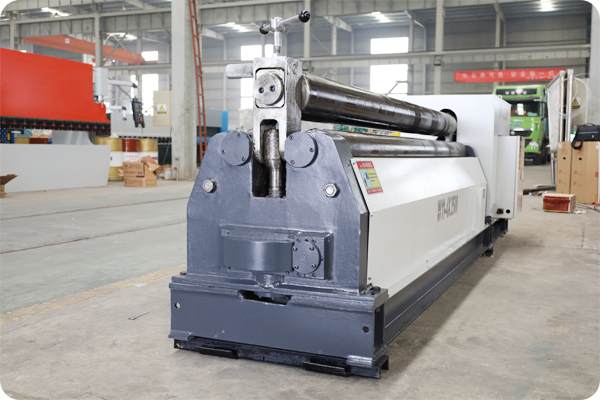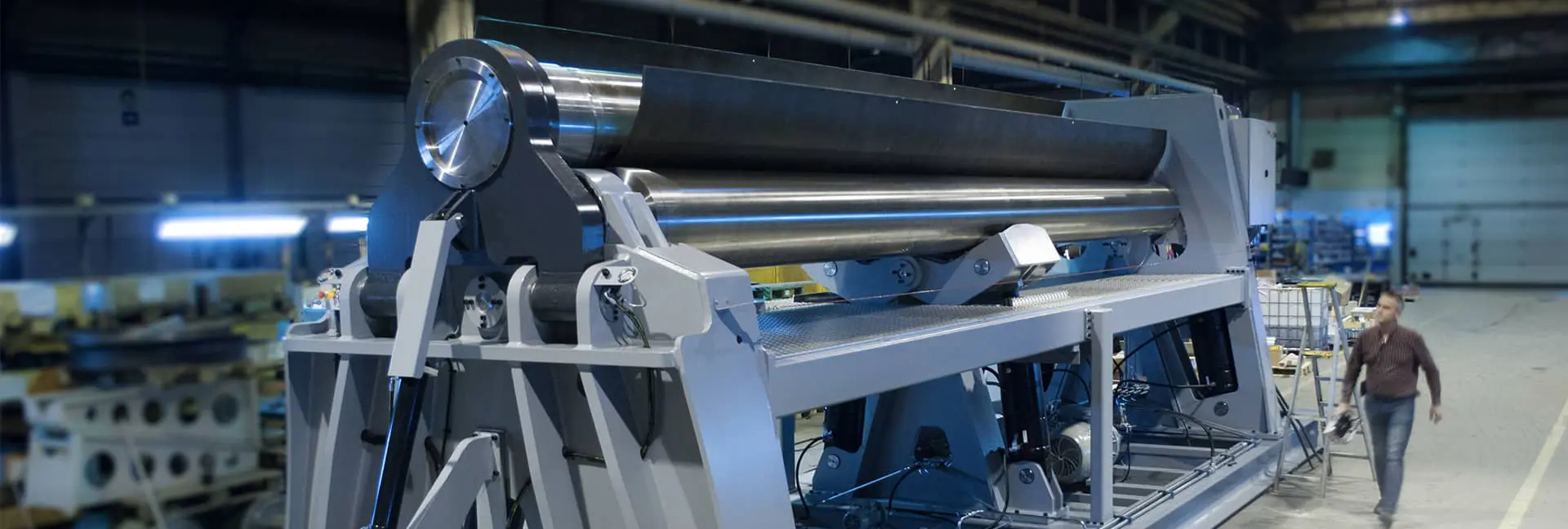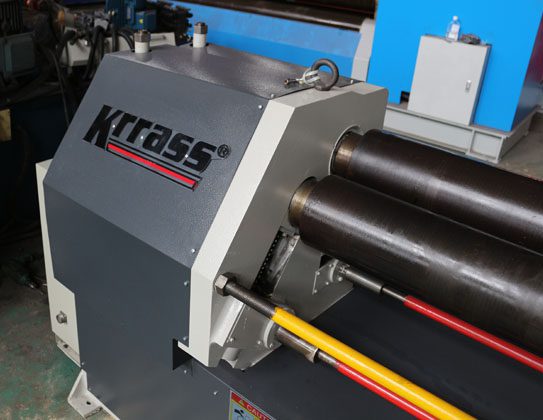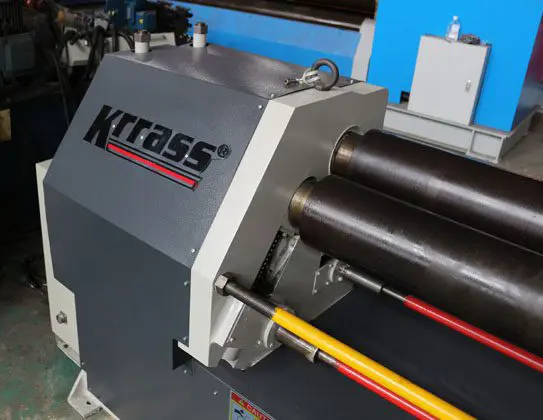Welcome to our comprehensive guide on Three Roller Rolling Machines, an indispensable tool in the field of metalworking and fabrication. This article delves into the intricate world of these machines, exploring their mechanics, versatility, and the pivotal role they play in shaping the future of manufacturing industries. From understanding their basic functions to exploring their applications in sectors like automotive and aerospace, this guide is your go-to resource for everything related to Rolling Machines.
- What is Three Roller Rolling Machines
- Understanding the Mechanics: How Three Roller Rolling Machines Work
- Key Components of a Three Roller Rolling Machine
- The Types of Materials Compatible with These Machines
- Different Models of Three Roller Rolling Machines
- Comparison: Mechanical vs Hydraulic Three Roller Machines
- Precision and Accuracy in Rolling
- Controlling Thickness and Shape: The Technical Details
- Safety Features and Protocols in Three Roller Rolling Machines
- Practical Applications of Three Roller Rolling Machines
- Maintenance and Troubleshooting of Three Roller Rolling Machines
What are Three Roller Rolling Machines?
Three Roller Rolling Machines, a cornerstone in the realm of metal fabrication, are specialized equipment designed for bending and shaping metal sheets into cylindrical or conical forms. They are known for their precision, versatility, and efficiency in handling various metalworking tasks. At the heart of these machines are three rollers: two fixed rollers and one adjustable roller. This trio works in unison to manipulate metal sheets into desired shapes, providing an indispensable tool for industries requiring high-quality metal forming, such as automotive, aerospace, and construction.
The key to understanding a Three Roller Rolling Machine lies in its design and operation. The machine operates by feeding a metal sheet between the three rollers. As the sheet passes through, the adjustable roller exerts pressure, bending the metal around the fixed rollers. This process can be repeated, adjusting the roller positions as needed, to achieve the desired curvature or diameter. Such machines offer unparalleled control over the bending process, allowing for precise and consistent results, which are vital in high-stakes industries where precision is paramount.
Moreover, these machines are celebrated for their ability to handle a wide range of metal thicknesses and types. From thin aluminum sheets to robust steel plates, Three Roller Rolling Machines can adapt to the demands of different materials, making them a versatile choice for various metalworking applications. Their robust construction and advanced design make them a long-term investment for businesses looking to enhance their metal fabrication capabilities.
Understanding the Mechanics: How Three Roller Rolling Machines Work
The magic of Three Roller Rolling Machines lies in their sophisticated yet straightforward mechanics. At its core, the machine's functionality hinges on the coordinated movement and pressure applied by its three rollers. This section aims to demystify the operational dynamics of these machines, providing a clear understanding of their mechanical prowess.
It all starts with the positioning of the metal sheet. The operator feeds the sheet between the three rollers: two positioned symmetrically and one adjustable roller. The central roller, often the adjustable one, is pivotal in controlling the bending radius. As the metal passes through the rollers, the adjustable roller applies pressure, causing the metal to bend around the fixed rollers. The degree of bending is finely controlled by adjusting the position of the central roller, either closer to or further from the fixed rollers.
The two fixed rollers provide a stable base for the metal sheet, ensuring a uniform bend. These rollers can also be adjusted to accommodate different widths and thicknesses of metal sheets. The synchronized movement of the rollers is the key to achieving precise bends. The machine's design allows for incremental adjustments, enabling the operator to fine-tune the bending process for exact specifications. This level of control is crucial for applications requiring high precision, such as in the aerospace or automotive industries.
Moreover, the mechanics of the Three Roller Rolling Machine are designed to minimize waste and improve efficiency. The precision with which these machines operate reduces the need for additional finishing processes, thereby saving time and resources. Additionally, the versatility of these machines to work with various metals and thicknesses makes them an invaluable asset in any metalworking facility.

Key Components of a Three Roller Rolling Machine
To truly appreciate the capabilities of a Three Roller Rolling Machine, it's essential to understand its key components. Each part plays a vital role in the machine's operation, contributing to its efficiency, durability, and precision. Let's break down these components and their functions.
The Rollers: The heart of the machine, the three rollers consist of two fixed rollers and one adjustable roller. The fixed rollers provide a stable base for the metal sheet, while the adjustable roller, often situated at the top, is responsible for bending the metal. The quality and material of these rollers determine the machine's ability to handle different metals and thicknesses.
Frame: The frame of the machine provides structural support, ensuring stability during operation. It's typically made from high-strength steel or other durable materials, capable of withstanding the stresses of metal bending.
Drive Mechanism: This includes motors and gears that power the rollers. The drive mechanism's design influences the machine's speed, precision, and ability to handle varying loads. Advanced machines often feature variable speed controls for enhanced flexibility.
Control Panel: The control panel is the user interface for the machine, allowing operators to adjust settings such as roller speed and position. Modern machines may include digital controls for more precise adjustments and programmable settings for repeat tasks.
Bearing and Support System: Bearings play a crucial role in reducing friction and wear between the moving parts, while support systems ensure alignment and stability of the rollers during operation.
Safety Features: Safety is paramount in any industrial equipment. Three Roller Rolling Machines include various safety features like emergency stop buttons, guards, and safety interlocks to protect operators during use.
The Types of Materials Compatible with These Machines
One of the defining features of Three Roller Rolling Machines is their ability to work with a diverse range of materials. This versatility not only broadens their utility across different industries but also makes them a valuable asset in any metalworking environment. Let's delve into the variety of materials these machines can handle.
Steel: Known for its strength and durability, steel is a common material used in metalworking. Three Roller Rolling Machines can handle various types of steel, including carbon steel, stainless steel, and alloy steel, making them suitable for construction, automotive, and manufacturing industries.
Aluminum: Aluminum is favored for its lightweight and corrosion resistance. These machines can efficiently work with aluminum sheets, which are often used in aerospace, automotive, and consumer goods.
Copper: Copper and its alloys, known for their electrical conductivity, are another group of materials that these machines can process. This makes them suitable for creating parts used in electrical components and plumbing.
Brass: Brass is often used for decorative purposes due to its gold-like appearance and is also a material that these machines can handle effectively.
Other Metals: In addition to these, Three Roller Rolling Machines are also capable of working with various other metals and alloys, offering flexibility in metalworking projects.

Different Models of Three Roller Rolling Machines
The Three Roller Rolling Machine comes in various models, each designed to meet specific needs and applications. Understanding the differences between these models is key to selecting the right machine for your requirements. Let's explore some of the common models available in the market.
Manual Three Roller Rolling Machines: These are the most basic models, requiring manual adjustment and operation. Ideal for small workshops or low-volume work, they are cost-effective and simple to use but may lack the precision and speed of more advanced models.
Electric Three Roller Rolling Machines: Equipped with an electric drive, these machines offer more power and efficiency. They are suitable for medium to high-volume work and provide more consistent results with less manual effort.
Hydraulic Three Roller Rolling Machines: These models use hydraulic systems for roller movement and pressure application. Known for their precision and ability to handle thicker, more robust materials, they are ideal for heavy-duty industrial applications.
CNC Three Roller Rolling Machines: At the high end are CNC (Computer Numerical Control) models. These machines offer the highest level of precision and control, with programmable operations that ensure consistency and efficiency in large-scale production. They are perfect for industries where precision is paramount.
Comparison: Mechanical vs Hydraulic Three Roller Machines
When it comes to Three Roller Rolling Machines, the choice between mechanical and hydraulic models is crucial, depending on the specific requirements of the task at hand. Both types have their unique advantages and are suited for different applications. Let's dive into a comparison of these two types of machines.
Mechanical Three Roller Machines: These machines are typically more straightforward in design and operation. They are generally more cost-effective and easier to maintain. Mechanical models are ideal for simpler, less intensive tasks and are commonly found in smaller workshops or for educational purposes. Their simplicity makes them accessible to users with basic training, but they may lack the precision and power needed for more demanding tasks.
Hydraulic Three Roller Machines: In contrast, hydraulic machines provide greater power and precision. They are equipped to handle heavier and thicker materials, making them a preferred choice for large-scale industrial applications. The hydraulic system allows for finer control over the rolling process, resulting in more accurate and consistent outcomes. These machines are typically more expensive and require more specialized maintenance, but their capabilities make them invaluable in settings where precision and power are critical.

Precision and Accuracy in Rolling
Precision and accuracy are the linchpins of successful metalworking, especially when it comes to rolling processes. Three Roller Rolling Machines are designed to meet these exacting standards, ensuring that each bend and curve is as precise as possible. Let's explore how these machines achieve such high levels of precision and why this is crucial in various industries.
Role of Design: The design of Three Roller Rolling Machines, particularly the arrangement and quality of the rollers, plays a critical role in precision. The adjustable roller allows for fine-tuning the bending radius, while the fixed rollers ensure stability and consistency. The precision of the machine's components directly translates to the accuracy of the bends it produces.
Control Systems: Advanced control systems, especially in CNC models, further enhance precision. These systems allow for precise adjustments in the roller positions and pressure, ensuring consistent results even with complex bending tasks. Programmable settings also mean that repetitive tasks can be executed with minimal variance, which is vital in large-scale production.
Material Handling: The way these machines handle different materials also contributes to their accuracy. Their ability to adapt to various thicknesses and types of metal without compromising on precision makes them indispensable in sectors where precise metal shaping is crucial.
Importance in Industries: In industries like aerospace, automotive, and construction, where the slightest inaccuracy can lead to significant issues, the precision and accuracy of metal components are non-negotiable. Three Roller Rolling Machines, with their precision capabilities, are thus integral to maintaining the high standards required in these industries.
Controlling Thickness and Shape: The Technical Details
A key aspect of metalworking with Three Roller Rolling Machines is the control over the thickness and shape of the metal being worked on. This control is central to the versatility and effectiveness of these machines. Let's delve into the technical details of how thickness and shape are controlled during the rolling process.
Adjustment of Rollers: The ability to adjust the position of the rollers is crucial for controlling both thickness and shape. The adjustable roller, in particular, can be moved closer or farther from the fixed rollers to change the bend radius and consequently the shape of the metal. This adjustment is key in achieving the desired curvature or angle in the final product.
Material Feed Rate: The rate at which the material is fed through the rollers also plays a significant role. A slower feed rate allows for more precision, particularly when working with thicker or harder materials. This control is essential for ensuring uniformity in the thickness and shape of the finished product.
Pressure Application: The pressure applied by the rollers is another critical factor. For thicker materials, more pressure is required to achieve the desired bend. Three Roller Rolling Machines are designed to apply this pressure evenly across the material, preventing warping and ensuring consistency in thickness.
Material Properties: Understanding the properties of the material being worked on is also essential. Different materials respond differently to the rolling process, and adjustments must be made accordingly to achieve the desired thickness and shape without compromising the material's integrity.
Technological Integration: Modern Three Roller Rolling Machines often incorporate advanced technologies, such as computerized control systems, to further refine the control over thickness and shape. These technologies allow for precise adjustments and real-time feedback, enhancing the machine's capabilities.
Safety Features and Protocols in Three Roller Rolling Machines
Safety is paramount in the operation of any industrial machinery, and Three Roller Rolling Machines are no exception. These machines come equipped with various safety features and protocols designed to protect the operator and ensure a secure working environment. Understanding and adhering to these safety measures is crucial. Let’s look at some of the key safety aspects of these machines.
Emergency Stop Buttons: Perhaps the most critical safety feature, emergency stop buttons allow operators to immediately halt the machine’s operation in case of an emergency. These buttons are typically easily accessible and positioned in multiple locations on the machine.
Protective Guards: Protective guards are installed around moving parts to prevent accidental contact. These guards are essential in preventing injuries from entanglement, crushing, or other hazards associated with moving machinery.
Safety Interlocks: Safety interlocks prevent the machine from operating when guards or covers are not properly in place. This feature ensures that the machine can only be operated under safe conditions.
Training and Manuals: Proper training for operators is crucial for safe operation. Comprehensive manuals and training sessions ensure that operators are well-informed about the machine's functions and safety protocols.
Regular Maintenance: Regular maintenance and inspections are vital to ensure that all safety features are functioning correctly and that the machine is in good working order. This includes checking for any wear and tear, especially on critical components like the rollers and the drive mechanism.
Operational Protocols: Established operational protocols, including clear guidelines on how to safely operate the machine, are essential. These protocols cover everything from the correct loading of materials to the safe operation of the controls.
Practical Applications of Three Roller Rolling Machines
Three Roller Rolling Machines play a pivotal role in the world of metalworking and fabrication, offering versatility and precision that are crucial in various manufacturing industries. This section highlights some of the key applications of these machines.
Applications in Metalworking and Fabrication: These machines are extensively used in shaping and bending metal sheets into cylindrical and conical forms. They are essential for creating components like tubes, tanks, and cylinders used in various machinery and structures. The ability to work with different metals, from thin aluminum to robust steel, makes them versatile tools in metal fabrication.
Role in Automotive Industry: In the automotive sector, precision is key. Three Roller Rolling Machines are used to produce parts with exact specifications, including body panels, frames, and exhaust components. The automotive industry relies on these machines for their ability to deliver consistent and precise results.
Significance in Aerospace: The aerospace industry demands the highest standards of precision and quality. Three Roller Rolling Machines are integral in creating components for aircraft, including fuselage sections and engine parts. Their precision ensures that the parts meet the stringent safety and performance standards of the industry.
Other Manufacturing Industries: Beyond automotive and aerospace, these machines find applications in various sectors such as construction, shipbuilding, and energy. They are used in the production of structural components, pipelines, and even in the fabrication of artistic installations.
Maintenance and Troubleshooting of Three Roller Rolling Machines
Proper maintenance and effective troubleshooting are essential for the longevity and efficiency of Three Roller Rolling Machines. This chapter covers the key aspects of maintaining these machines, addressing common issues, and the potential upgrades for older models.
Routine Maintenance for Longevity and Efficiency: Regular maintenance is crucial to ensure the smooth operation of Three Roller Rolling Machines. This includes periodic lubrication of moving parts, checking for wear and tear on rollers and bearings, and ensuring all electrical components are functioning correctly. Routine inspections help in early identification of potential issues, thereby preventing costly downtime.
Common Issues and Solutions: Some common issues that operators may encounter include misalignment of rollers, uneven bending, and operational inconsistencies. Many of these problems can be resolved through calibration of rollers, checking and adjusting pressure settings, and ensuring that the material is properly fed into the machine. Regular training for operators on troubleshooting techniques is also beneficial.
Upgrades and Modernizations for Older Models: For older models of Three Roller Rolling Machines, upgrades and modernizations can significantly improve performance and efficiency. This can include retrofitting with newer control systems, upgrading the motor or drive mechanisms, and replacing worn-out parts with modern, more durable materials. These upgrades not only extend the machine's life but also enhance its capabilities to meet current industry standards.
Choosing the Best Three Roller Rolling Machine
In conclusion, selecting the right Three Roller Rolling Machine is crucial for achieving precision, efficiency, and reliability in metal fabrication and manufacturing. As you consider your options, we highly recommend exploring the offerings of Krrass, a leader in the manufacturing of Rolling Machines and Sheet Metal Machines. Krrass is renowned for its innovative solutions and commitment to quality, making it a top choice for businesses seeking advanced metalworking technologies. Discover how Krrass can elevate your manufacturing capabilities by visiting www.krrass.com. Embrace the future of metalworking with Krrass – where precision meets innovation.
Read More:
Four-Roll Plate Rolling Machine: Principles and Operating Procedures





